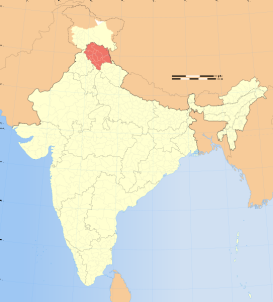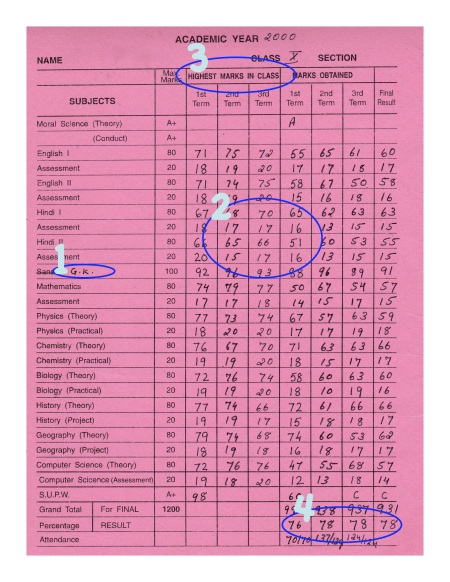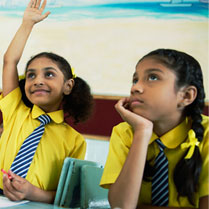.
This American family sent their daughter to a local school in India… hear more about their experiences, including some very funny stories!
See a previous post on the same family.
.
This American family sent their daughter to a local school in India… hear more about their experiences, including some very funny stories!
See a previous post on the same family.

For the next several weeks, we’ll look at report cards from around the world.
The British Empire founded Dalhousie (named after a British official) as a hill station in the 1850’s. Nested the Indian state of Himachal Pradesh, Dalhousie remains a popular tourist destination with incredible views of the Himalayas. Though a small city, with a population of about 7,500 people, residents are relatively well educated

Here’s the report card! The blue circles highlight a few interesting aspects of the report and the numbers correspond to notes below the image.
 1. G.K. ~ A Course Called General Knowledge
1. G.K. ~ A Course Called General Knowledge
Students take a class called “General Knowledge,” from text books like the one at the right (which is available online). This course focuses on countries and capital cities, language, literature, plants, animals, sports, entertainment, science and the arts. Do you know the capital of Yemen? (answer below)
2. Numbers Everywhere!
While some report cards feature the teacher’s notes on a student’s progress in class, this report card focuses on numbers. This correlates to the test-based culture of the Indian educational system; tests can easily be converted to numbers.
3. Here are your marks… here are the highest marks in the class
The Indian educational system tends to be competitive (possibly an understatement), and teachers consider the highest marks* as the standard of achievement. Compare this to the American educational system where students may compare their grades to the average.
* Indians refer to “grades” as “marks.”
4. 78’s… A C-average Student? Nope!
This student achieved high 70’s in the three terms. That’s not great in the United States, but it’s fantastic in India. This student ranked 5th in her class! The pupil should be proud of her achievements.

5. Academics
This section of the report card gives the letter grade equivalent of the percentage grade. While a 78 would be a “C+” in the United States, it constitutes a “B” in India.
Here’s a chart to interpret the grades
|
90-100 |
A+ |
|
80-89 |
A |
|
70-79 |
B |
|
60-69 |
C |
|
50-59 |
D |
|
40-49 |
E |
6. Self-Confidence and Personal Hygiene
When is the last time your teacher rated your self-confidence… or your personal hygiene? This section of the report card deals with soft skills and the rating system is more flexible as well (letter grading, rather than the numbers that were so prevalent on the first page). When teased about her less-than-perfect hygiene scores, this student responded that the score included… handwriting! Obviously “Hygiene” has a different meaning in the Indian educational system than it does in the U.S., and includes personal presentation both in person and in work.
7. Very Good and Congratulations
“Very good and congratulations” are the only comments from the teacher (though this may be different for a trouble student). This differs greatly from report cards that concentrate on comments rather than grades (examples to come!)
Report card analysis to look forward to: Nepal, Malawi, Australia, Canada, Mexico and more!
* The capital of Yemen is Sana’a.
I recently interviewed an American family about their experiences while living in India and sending a child to a local school. They told me a fascinating story (I’ve taken a few creative liberties, but the issues are the same).
 Mom and Dad attended the parent-teacher meetings at an English-medium, independent school in India. They spoke briefly to each teacher: the “maths” teacher, the science teacher, the Hindi teacher and finally the English teacher. The English teacher said, “You’re daughter is lovely, but her accent is so thick that no one understands her. Also, she speaks too fast.” Well, Dad was perplexed, “Accent? What accent?”
Mom and Dad attended the parent-teacher meetings at an English-medium, independent school in India. They spoke briefly to each teacher: the “maths” teacher, the science teacher, the Hindi teacher and finally the English teacher. The English teacher said, “You’re daughter is lovely, but her accent is so thick that no one understands her. Also, she speaks too fast.” Well, Dad was perplexed, “Accent? What accent?”
Then the teacher went on to talk about writing. She said, “Your child’s handwriting is very messy and I always have to take points off.” Mom and Dad were not too concerned about handwriting and asked instead about the content of her writing, but the teacher continued to speak about handwriting. “Your daughter must use a computer at home?”
“Well… yes,” Mom replied.
“Does everyone have a computer in the United States? In India, children do not have computers, so handwriting is very important.”
Not sure what to say, mom replied, “But what about the subject matter of her writing?”
The teacher continued, “You see, in India, handwriting is very important because we are preparing our children for The Boards*, and their handwriting must be legible in order to be graded.”
“But she won’t be taking The Boards.”
“She won’t?”
“She will be moving back to the United States.”
The parents ended the story with a laugh, “well, she had much better handwriting when she returned to the United States!”
In a way, the tale is funny, but it’s also telling of educational values. While the parents were trying to find out about the content of their child’s writing, which usually constitutes the most important aspect of writing in the American educational system, the teacher showed much more concern for her handwriting, crucial for passing exams that can open or close doors to higher education in India. The parents and teacher reached an impasse.
This anecdote illustrates important cultural differences in education, that can make an international education challenging. While the value may be a relatively small matter (who spends much time thinking about handwriting in the United States?), it can have serious implications (computers per capita definitely marks wealth disparity on a national level) and serious consequences (failing the all-important exams). These are the small factors parents might not even think to consider when choosing to send a child to a local school.
That being said, this particular child had an overwhelmingly positive, life-changing experience. School Choice International will post a video of the interview soon… tune in to find out more about this fantastic family.
See a video interview on the same family!